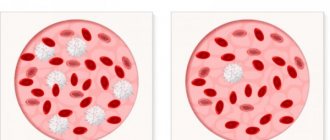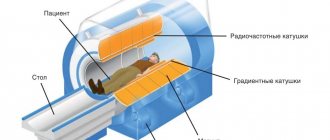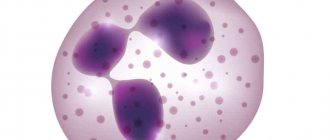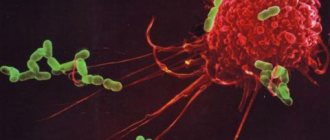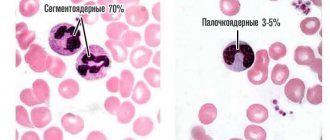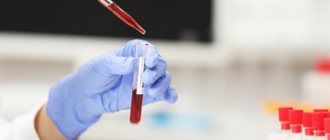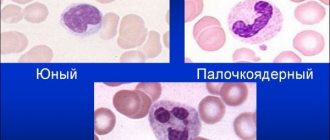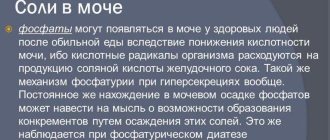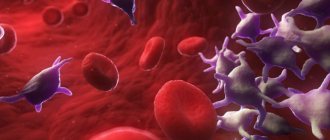Ekaterina Smolnikova
Practicing endocrinologist (10 years of experience). He has extensive experience working in private and public clinics in Russia.
Ask a Question
Last updated - February 5, 2020 at 18:04
When a child's blood counts change, this should alert parents. In this case, visiting a doctor is mandatory, since a specialist can not only determine the reasons for the decrease in neutrophils, but also prescribe treatment that is adequate to the situation. You need to understand that a low level of neutrophils in a child’s blood indicates very low immunity, so you need to act immediately.
What are neutrophils?
Blood contains a specific set of cells, and each type performs its own function. For example, red blood cells supply oxygen, platelets prevent bleeding, lymphocytes and leukocytes protect the body from infectious agents. Neutrophils are a type of white blood cell. They are designed to resist the penetration of fungal and bacterial flora.
There are two types of neutrophils:
- Band cells are immature young cells that mature over time and acquire a nucleus.
- Segmented cells are “warriors” of the immune system that destroy harmful microorganisms.
If an acute infectious process occurs in a child’s body, segmented neutrophils always increase.
What is called by an unclear word - neutrophils?
Neutrophils are those cells that belong to leukocytes and are the largest group. Neutrophils are an important part, as they kill harmful things in our body: bacteria, both in the blood and in the tissues.
To make it clear to every parent who does not have a medical education, we can say this in everyday language:
- Neutrophils are useful rescue cells. When they encounter a pathogenic bacterium in our body, they “eat” it, then take it apart and destroy it inside themselves, and then the neutrophils die themselves;
- Neutrophils exist in 6 states, 2 of which are considered normal, and the other 2 are an indicator that the child has some kind of disease.
All neutrophils are present in our body at once, that is, in all their 6 states. But doctors examine only 4 of them, as well as the relationship between these neutrophils.
In a general analysis, these 4 groups can be studied; they are designated as “leukocyte formula shift.”
To find out whether a child has low neutrophils, consider the following groups of these cells:
- Myelocytes;
- Metamyelocytes;
- Band;
- Segmented neutrophils.
The last 2 groups are the very first to enter into a “war” with dangerous bacteria and, as a rule, their means are enough to suppress the disease. But if the disease turns out to be not so simple, then other neutrophils can also come into support, even those that are still undergoing their maturation and are absent in healthy children (myelocytes and metamyelocytes).
Norm of neutrophils in children
The number of neutrophils in a person’s blood depends on his age.
- up to 1 year - 16-45%;
- 1-2 years - 28-48%;
- 2-4 years - 32-55%;
- 4-6 years - 32-58%;
- 6-8 years - 38-60%;
- 8-10 years - 41-60%;
- 10-16 years - 43-60%;
- over 16 years old - 47-72%.
Question to the expert
What should you definitely pay attention to in the percentage ratio of segmented and band neutrophils?
If the number of neutrophils is below the normal limit, this condition is called neutropenia, and if it is higher, it is called neutrocytosis.
What are neutrophils responsible for?
This is one of the subtypes of leukocytes (blood protective cells). They are responsible for protecting the immune system and the entire body from pathogenic microflora that provoke a number of diseases.
These cells are the first to encounter bacteria, viruses, and other pathogens that enter the body and then engulf them. The functions of neutrophils are divided depending on their type:
- Band neutrophils, or immature ones, promote rapid healing of injuries, wounds, and abrasions.
- Segmented neutrophils - absorption of pathogenic microflora, viruses.
When an inflammatory process begins to develop in the body, the number of protective cells increases sharply (neutrophilia), and this is a normal physiological phenomenon that helps the immune system.
But this does not always happen; a decrease in neutrophils may also be observed. If neutrophils in a blood test are low, this is a sign that the immune system is in a depressed state, which means that if an infection occurs, the body will not be able to cope with it on its own.
Reduced neutrophils in the blood of a child
Neutropenia is accompanied by severe diseases caused by infectious or fungal infections. The immune system will not respond correctly to pathogens, and therefore the child becomes more susceptible to bacterial infections, most often stomatitis and gingivitis. In addition, delays in psychophysical development are possible.
Article on the topic:
What is an APTT blood test? What should the indicators be?
Neutropenia can occur in mild, moderate and severe forms. Pathology differs into congenital and acquired.
Congenital pathology can be expressed in the following types:
- “Lazy leukocyte” syndrome – a child from a very early age systematically encounters inflammatory pathologies.
- Cyclic neutropenia - the nature of the pathology is repetitive, and in most cases is combined with agranulocytosis - a very significant decrease or complete absence of neutrophil granulocytes.
- Kostman's syndrome - there are no mature forms of neutrophils in the blood plasma, signs of pathology appear immediately after the baby is born.
- Familial benign neutropenia. In this case, there is no clinical picture of the pathology, and no specific therapy is required.
In the first year of life, a child is most often diagnosed with a chronic form of benign neutropenia - the quantitative composition of cells changes over different periods of time. Neutrophil concentrations may range from low to normal. In most cases, by the age of 3, this disorder resolves on its own. As for the acquired form of pathology, it is associated with the influence of biological, physical and chemical factors.
Segmented neutrophils are reduced, and lymphocytes are increased
If segmented neutrophils are reduced and lymphocytes are increased, the causes of this condition may be:
- viral diseases;
- HIV;
- tuberculosis;
- problems with the thyroid gland;
- lymphocytic leukemia;
- lymphosarcoma.
Thus, we can conclude: if lymphocytes are increased and neutrophils are decreased, then there is a focus of infection in the body, most likely viral. However, the results of the blood test must be compared with the clinical picture.
If there are no signs of illness, you may be carrying a virus. When the level of granulocytes decreases with a simultaneous increase in lymphocytes, a full examination is required, since dangerous pathologies such as hepatitis and HIV cannot be excluded.
Symptoms
The clinical picture of decreased neutrophils in the child’s blood certainly depends on the disease that provoked this process; most often you can notice:
- skin rash;
- increased frequency of viral infections;
- elevated or low-grade fever;
- headache;
- increased heart rate;
- fungal pathologies;
- frequently recurring acute respiratory viral infections.
If neutropenia is severe, the child may have fever, intoxication, and destructive pneumonia.
Important! If a child often has sinusitis, stomatitis, or swollen lymph nodes, this cannot be ignored. It is believed that these are the first signs that indicate the development of neutropenia.
When neutrophils are elevated
If a child's blood test shows high neutrophils, the condition is called neutrophilia and can be caused by many factors. For example, if the increase is insignificant, there is a possibility that this is the body’s reaction to the baby’s activity - he was running or playing happily before blood sampling. When neutrophils are significantly elevated, the doctor will recommend undergoing an examination. Diseases and other factors that can cause an increase in neutrophils:
- leukemia;
- vaccination;
- peritonitis;
- pneumonia, otitis media, sepsis, bronchitis, tonsillitis;
- third and fourth degree burns;
- abscesses;
- hemolytic anemia;
- diabetes;
- trophic ulcers.
If blood counts deviate from normal, the doctor will prescribe an examination of the child to identify the causes of the decrease in neutrophils.
Also, neutrophils can be elevated against the background of a severe cough that occurs during ARVI. This may indicate a bacterial infection that should be treated with antibiotics.
Experts say that the degree of increase in the number of these cells depends on the strength of the inflammatory process. In this regard, if the level of neutrophils increases significantly, you should try to undergo all the examinations prescribed by your doctor so that he can make a diagnosis as quickly as possible. As a rule, treatment should begin immediately.
Sometimes blood tests show a shift in the leukocyte formula - when the overall level of leukocytes is normal, but the number of segmented cells is significantly higher than normal. This picture is observed in some diseases:
- infectious diseases that are asymptomatic;
- inflammatory processes in acute form;
- different types of tumors.
As you can see, if there are any deviations in blood test results, you should immediately examine the child. The sooner a diagnosis is made and therapy is started, the easier it is to cure the disease.
Causes
A decrease in the concentration of neutrophils in a child’s blood can have various reasons - viral and fungal diseases, disorders of the bone marrow, problems with the thyroid gland. Also, the death of neutrophils can be provoked by long-term use of antibacterial agents, pain medications, and so on. As already mentioned, neutropenia, although in rare cases, can still be congenital - the bone marrow does not produce enough of these blood cells. Also, the number of neutrophils decreases with anemia, chemical poisoning, anaphylactic shock, and acute form of leukemia.
Article on the topic:
What does the level of creatinine in the blood show in women? What should be the normal values?
Important! Sometimes a decrease in neutrophil tests may be due to improper blood donation. The result may be distorted if the baby is very overexcited or if he ate a heavy meal the day before.
Reasons for the increase
An increase in the number of segmented neutrophils is usually observed in the following cases:
Infectious and inflammatory processes
Classics of the genre. This should include all possible disorders that relate to the penetration of foreign agents into the body. Bacteria, viruses or fungi.
The intensity of the increase in cellular structures, the speed and final volume of leukocytes depend on the specific disorder. The stronger the disease, the more abnormal agents and their waste products, the higher the level of neutrophils.
Symptoms depend on the pathological process. In general, there are always such deviations from the norm:
- Temperature increase. To what extent - you need to look at the situation.
- Weakness.
- Drowsiness.
- Feeling very tired.
- Manifestations of intoxication of the body: nausea, headache. Plus or minus. Everything is determined by the diagnosis.
- There are also focal signs of the pathological process. If it is tonsillitis - sore throat. Pneumonia, bronchitis - shortness of breath, chest discomfort, and so on.
The treatment is specific and is carried out under the supervision of a therapist and a specialized specialist (depending on the disease).
Antibiotics, antivirals, immunomodulators, anti-inflammatory drugs, antipyretics are prescribed to bring down the temperature.
Next, the course of treatment is adjusted based on the dynamics of the patient’s condition. This applies to both dosages and the names of the drugs themselves.
Autoimmune inflammation
They occur no less often, but are fundamentally different from infections. In this case, there are no traces of pathogenic structures. The body begins to react to its own tissues and cells inappropriately and attacks them.
Segmented neutrophils, basophils, and eosinophils also participate in this process. All formed cells of the immune system.
The most common diagnoses are:
- Rheumatoid arthritis.
- Myocardial damage.
- Gout.
- Lupus erythematosus.
- Thyroiditis.
And much more. This also includes allergic reactions, which will be discussed below.
Treatment is provided by rheumatologists and immunologists. Glucocorticoids are prescribed. Prednisolone is used as a starting point.
Further, the strength of the drug is varied based on the essence of the pathological process and its severity.
In the most extreme cases, if the condition is resistant and does not respond to therapy, immunosuppressants are used. They inhibit the production of protective cells and thereby eliminate the negative impact.
Sepsis
Occurs against the background of a long-term infection or open injury. The second, not entirely accurate name for this pathological condition is blood poisoning.
In fact, we are talking about a generalized inflammatory process. It covers the entire body, systems and organs suffer. If nothing is done, there is a high probability of rapid death.
Segmented neutrophils are increased to eliminate bacteria, viruses, fungi, and their metabolic products, slow down the inflammatory process and somehow achieve a state of balance. Therefore, the growth is significant, clearly visible and rapid.
Attention:
The combination of speed and high rates often indicates either sepsis or gangrene.
Infectious disease specialists provide treatment. At first, the patient has to be placed in intensive care in order to provide the victim with thorough medical care and provide supervision: the condition can worsen at any moment.
Loading doses of antibiotics are prescribed, as well as anti-inflammatory drugs, medications for viruses and fungi.
Even these measures are sometimes not enough. They resort to hardware blood purification using plasmapheresis methods. But this is more of an auxiliary measure.
Rehydration solutions are administered and infusion therapy is prescribed in order to quickly remove waste products of abnormal agents and toxins from the body’s structures.
The prognosis is vague even with high-quality treatment. It all depends on the moment the correction begins.
Malignant oncology
Often the reason for the increase in segmented neutrophils is the poisoning of the body with tumor decay products: formed cells, leukocytes act as a kind of scavengers that utilize waste substances and particles. These include dead malignant cells.
You can expect tumor destruction starting from the second or third stage of the pathological process. Because there are so many cytological structures that there is no longer enough “food” for everyone. Some cells die from “gluttony”, others from nutritional deficiency. The bottom line is one thing: tissue breakdown and poisoning of the entire body.
By the way, hence the regular or even constant increase in body temperature, weakness, drowsiness, symptoms of general intoxication, sudden weight loss and other “delights” of this condition.
As for neutrophils, their concentration increases in parallel with the growth of the tumor. The further it goes, the worse the patient will become.
Thermal injuries
An increase in segmented neutrophils in the blood occurs with massive burns, since the products of protein destruction, which were located in the thickness of the dermis, enter the channel. The “garbage” needs to be removed. Granulocytes do this job.
The larger the affected area, the worse the situation overall. But that's not the problem. If nothing is done, fatal complications for the patient are very likely.
With burns of more than 20% of the body, there is a high probability of the following problems:
- Kidney failure from too much protein.
- Cardiac arrest due to overload.
- Heart attack.
- Coma.
To prevent this from happening, the patient is placed in a burn department or intensive care unit. Depends on the condition. But no one gives guarantees of survival.
Allergic reactions
Segmented neutrophils increase due to an autoimmune response, a false attack of the body's own defense cells on the body's tissues. There are no objective reasons for this.
As a rule, allergies develop to food dyes, natural pigments of natural origin, dust particles and other harmless substances.
Usually this is the result of hypersensitization of the body. Increased sensitivity to the limit after an infection.
Allergies can manifest themselves in different ways. In some cases it is a common skin rash or urticaria. In others - anaphylactic shock, Quincke's edema. That is, very dangerous, potentially fatal violations.
Immunologists treat patients. The goal is to restore the body's normal sensitivity and reduce the degree of sensitization.
Corticosteroids like Pridnisolone are prescribed. As in other cases, immunosuppressants may be required. Fortunately, this is a relatively rare option.
Attention:
It is impossible to completely cure allergies. All that remains is to stop exacerbations and prevent relapses of the pathological process.
Parasitic infestations
Simply put, worms. Not necessarily in the classical sense. Those located in the intestines. There are different worms.
- Some prefer the hepatic ducts (giardia, flukes).
- Others, like echinococci, even settle in the lungs, brain, and also in the structures of the digestive tract.
- Opisthorchis, found in river fish, can potentially infest any organ that has a sufficient blood supply. Even the human eye. There are many options.
Be that as it may, parasites release waste products into the bloodstream. This is a kind of signal for the body to start an immune reaction.
Neutrophils attack intruders and destroy them along with eosinophils, which are more adapted for the purpose of combating helminths.
The more worms there are, the more active they are, the more intense the immune response itself. It is necessary to check for parasitic infestation almost in the first place.
The treatment of the pathological process is carried out by specialists in parasitology. Special medications are prescribed. The doctor will choose the exact name; there are many of them and they are usually specific. That is, they act on parasites of a certain type and origin.
It is strongly recommended to undergo treatment in a hospital. Because when they decay, worms poison the body and can cause complications.
Myocardial infarction
Oddly enough, an acute circulatory disorder in the myocardium can become the culprit for the growth of segmented neutrophils.
If you take a closer look, there is nothing unusual. The fact is that in this emergency condition, myocardial cells are destroyed. The accumulated substance known as myoglobin is released. This is protein.
Like all chemical components of this type, it has an increased allergenic potential. The body reacts to the compound as potentially dangerous and produces more formed cells.
In addition, you need to cleanse the body of waste products. These two goals provoke an increase in the content of segmented neutrophils in the blood.
There is no need to do anything special. High levels of formed elements and white blood cells will disappear on their own as soon as the acute condition passes.
It is important to focus on myocardial infarction. Conduct a course of maintenance therapy and prescribe rehabilitation measures. A cardiologist is dealing with the problem.
All symptoms of a pre-infarction condition are described in detail here.
Severe forms of renal failure
Normally, it is the excretory system that eliminates waste products, cellular debris, and waste proteins.
If the filtering paired organ fails, these poisons are absorbed back into the blood and poison all systems. The increase in neutrophil concentration is due to a reflex attempt to eliminate toxic components.
The most common causes of renal failure are long-term infectious-inflammatory and autoimmune processes. You can also name parasitic type disorders, oncology, anatomical changes (prolapse of the kidney, wrinkling, etc.).
Treatment is carried out by specialists in nephrology (not neurology). Diuretic drugs are prescribed, which stimulate the natural functioning of the paired organ.
If the state is neglected, they cannot be used. Doctors resort to hardware methods of blood purification, hemodialysis.
The only radical and effective way of recovery is a kidney transplant. Finding a suitable donor is not an easy task. That's why patients wait for years.
Many do not have time for the operation and die before the right moment arrives.
Some forms of poisoning
Intoxication with heavy metals. For example, lead, mercury. This also includes pathological processes provoked by volatile compounds. For example, sulfur fumes or other agents.
Most often, employees of hazardous chemical enterprises and people living in areas that are unfavorable from an environmental point of view encounter such problems.
The treatment is specific. It is dealt with by toxicologists or therapists if there are no specialized doctors nearby. A detoxification course is prescribed. When possible, use specific antidotes.
The correction takes place within the walls of the hospital to provide the patient with sufficient supervision.
By the way, some drugs can also lead to poisoning. For example, corticosteroids. The probability must be assessed based on the annotation. Information from the instructions for use.
Injuries suffered
After any injury, even a bruise, even a fracture, the inflammatory process begins.
So the body, on the one hand, eliminates a possible infection, a secondary septic phenomenon. On the other hand, it increases the local regenerative abilities of tissues and helps restore anatomical integrity.
Granulocytes also participate in this process. In particular, neutrophils. The degree of growth depends on the nature of the pathological condition.
A bruise will practically not provoke changes. The same cannot be said about an open wound with extensive tissue damage.
Treatment is carried out under the supervision of a traumatologist and surgeon. Specific measures are required: operational or conservative. The question remains at the discretion of the doctors.
These are the main, but not all possible provoking factors.
Infections that reduce neutrophils
Infectious diseases that can reduce the number of neutrophils in the blood are the following:
- chicken pox;
- fungal infection;
- viral hepatitis;
- rubella;
- influenza and parainfluenza;
- acute respiratory infections;
- measles;
- typhus and paratyphoid;
- herpes virus;
- tuberculosis;
- endocarditis;
- Epstein-Barr virus;
- meningitis, sepsis;
- tularemia.
All these pathologies negatively affect the functioning of the bone marrow, therefore, the formation of neutrophils is disrupted, and the destruction of their structure is accelerated.
What to do if there is a high level of neutrophils in the blood?
First, consult your doctor for additional examinations. An increase in this indicator above the norm indicates a huge number of diseases.
- Get enough sleep and sleep up to 8 hours a day.
- Do not abuse psychotropic substances and medications.
- Do not overeat and dilute your diet with foods rich in vitamins.
- Eat more foods containing unsaturated fatty acids: fish oil, cod, salmon, olive oil.
- Do not overexert yourself physically or mentally. Stress affects the level of neutrophils in the blood and can aggravate the underlying disorder.
- Develop a dynamic stereotype: sleep, eat, exercise at a clearly designated time of day. This will teach the body to prepare for various tasks and reduce the level of psychological stress.
- Visit your doctor regularly to have your condition diagnosed or treated.
Advice! A healthy lifestyle will help normalize neutrophil levels, but will not eliminate the underlying disease. In case of serious pathologies, it is necessary to adhere to the doctor’s recommendations. Often, neutrophilia goes away on its own and spontaneous long-term remission occurs.
If segmented neutrophils are low in the blood, this is always a symptom of the development of some serious disease in the human body.
A neutrophil is a type of granular leukocyte, a formed blood element. It, in contrast to the erythrocyte and platelet, which are not cells, is a true, highly specialized nucleus of the neutrophil, which is segmented, which is why such a granular leukocyte is also called segmented. This nuclear segmentation helps the neutrophil migrate through tissues. A neutrophil has from three to five such segments. They are connected to each other by thin bridges, and in the female body, the genital chromatin, otherwise known as the tympanic rod, is also observed in the electron diffraction scan. Such heterochromatin is spiralized, because synthetic processes are not visible in a mature cell. In addition to the segmented neutrophil, there are immature neutrophils: young and band neutrophils.
If the electronogram shows that segmented neutrophils in the blood are reduced, this may signal the development of leukopenia (if less than 4 * 109 / l) or even neutropenia (if less than 1.8 * 109 / l). A decrease in the number of leukocytes to a level of 2-3 *109/l indicates the presence of an infection in the human body. These can be infections such as influenza, paratyphoid B and A, rubella, typhoid fever, chickenpox, measles, viral hepatitis, polio, typhus, mumps, malaria, visceral leishmaniasis, psittacosis and others. If segmented neutrophils are reduced to the level of 1*109/l and thrombocytopenia and anemic signs develop, these numbers indicate acute leukemia, deficiency of folic acid or vitamin B12, metastases in the bone marrow, aplastic anemia. The level of leukocytes in the blood also decreases in diseases such as thyrotoxicosis, diabetes mellitus, hypothyroidism, anaphylactic or stomach shock, neurosis, collapse and others. Even if a person’s physical activity has simply increased (and significantly), he is in an excited state (emotional, psychological), hypothermia has set in or a pain syndrome has appeared, there may be a decrease in segmented neutrophils in the blood.
When segmented neutrophils are low in a child, this should alert the doctor. It is quite possible that an inflammatory process is going on in the child’s body, and a latent form of some dangerous disease is developing.
A neutrophil, like any granulocyte, has specific granules, but they are smaller. These granules contain special substances that contribute to the success of phagocytosis in the destruction of bacterial walls. This is why it is so important that neutrophil levels remain at normal levels, neither decreasing nor increasing. If the doctor, having received the results of a blood test, sees that segmented neutrophils are increased or decreased, he again sends the patient for a second analysis. When the second sequential analysis confirms the results of the first, the patient should be referred to a hematologist for consultation.
When the level of segmented neutrophils in the blood increases, neutrophilia develops. What diseases are characterized by such an increase in leukocytes? For intoxication, acute infectious diseases, malignant neoplasms, that is, for those in which microbes are introduced into the human body, foreign substances and cell decay products accumulate. These can be infections such as mycosis, bacterial or viral infection, as well as rickettsiosis, spirochetosis, tick-borne encephalitis and others. It is possible to increase neutrophils in human blood during the following inflammatory processes: gout, rheumatism, myositis, rheumatoid arthritis, ischemic necrosis, tissue damage, pancreatitis and many others. If a person has uremia, necrosis of liver cells, cancer, eclampsia, blood diseases, the level of neutrophils may also increase.
Neutrophils perform two functions in our body: bactericidal and phagocytic. An increase or decrease in their amount in the blood indicates that they cope with these functions successfully.
Segmented neutrophils are one of the main indicators of the leukocyte formula of a clinical (general) human blood test.
Changes in this component make it possible to suspect such serious conditions as infectious diseases, poisoning, malignant blood diseases, complications of treatment with glucocorticosteroids. An objective assessment of the number of neutrophils is carried out in comparison with other cells.
The norm is different for an adult and a child, as well as for a man and a woman in a certain physiological state. This blood test indicator is dynamic - a segmented neutrophil circulates in the blood for only 8-10 hours. Changes in the patient's condition are assessed by the relative and absolute content of segmented and other blood cells.
The count is carried out by a laboratory doctor using a microscope or analyzer device.
Deviations develop both under pathological conditions and under the influence of physiological factors.
In children
In children, the norm changes in accordance with age and the needs of the body.
Even during the first weeks of life, this indicator varies significantly. Segmented neutrophils in a child:
- make up 60% of the content of all neutrophil cells in the first day after birth;
- decrease to 50-40% on day 5 (the number of lymphocytes and neutrophils is equal);
- continue to decrease to 25-30% throughout the entire infant period;
- slowly increase to 45-50% until age 5 years.
In preschool children, pediatricians note 2 episodes of the so-called crossover of lymphocytes and neutrophils - their equal percentage percentage in the peripheral blood. This occurs in the first week of a little person’s life and at 5 years of age.
The norm for a teenage child differs slightly from that of an adult and is 45-65%.
Among women
In men
In men, there are no fluctuations in the content of segmented neutrophils: the norm remains stable for any age. Only severe stress and excessive physical activity provoke a short-term physiological increase in this indicator. What it is - a physiological change or the onset of pathology - will become clear with repeated research.
Congenital diseases
As for inherited pathologies, they can provoke the following disturbances in the number of neutrophils:
- benign forms - cyclic or familial neutropenia;
- malignant forms - Shwachman-Diamond syndrome, severe congenital neutropenia.
It must be said that congenital neutropenia in children is a rare pathology; for example, Shwachman-Diamond syndrome is diagnosed with a frequency of 1 case per 10-50 thousand children. As a rule, this pathology is detected in a child in the first months of life - children are developmentally delayed, eat poorly, and suffer from frequent diarrhea.
Another congenital disease in which the number of neutrophils is reduced is Kostman's syndrome. In this case, there is a blockade of maturation of segmented neutrophils.
The most common childhood neutropenia is benign neutropenia. It is associated with the individual developmental characteristics of the child, does not pose any health hazard, and goes away by the age of 3-5 without treatment. This form of pathology is diagnosed at 6-12 months.
Norm and functions of elements
Blood analysis of young patients is especially important and informative. Children are not always able to accurately describe the symptoms that bother them, and parents cannot even suspect the development of the disease.
The number of segmented neutrophils during the study will make it possible to understand the condition of a small patient and establish the correct diagnosis.
For children and adolescents, the following indicator standards have been established:
- newborns – 45 – 80%;
- babies from one month to six months – 16 – 45%;
- babies up to a year – 16 – 45%;
- children from one to 6 years old - 25 - 60%;
- in a child 7 - 12 years old - 35 - 65%;
- teenagers - 40 - 65%.
In a child, as in an adult, segmented neutrophils play a very important role. The cells of the circulatory system protect against the effects of bacteria and other microorganisms.
When tissues and organs become infected with dangerous elements, neutrophils quickly move to the site of infection and absorb the source of the disease.
Thanks to their unique structure, the protective elements envelop the pathogenic microorganism and destroy it, but at the same time they also die.
As a result of this process, the level of segmented neutrophils is significantly increased.
When a malignant tumor appears, a group of these leukocytes is practically powerless. When the indicators are normal, this indicates good health and strong immunity.
And if a child has deviations in the number of segmented particles, then this indicates the development of pathology.
With a decrease in the number of protective elements in the body, children may experience the following ailments:
- frequent colds;
- sudden changes in temperature;
- pneumonia;
- pustular rashes on mucous membranes;
- increased sweating;
- arrhythmia and tachycardia;
If the rate of segmented fragments is very low, then there is a likelihood of the disease progressing to a severe form of neutropenia.
With this disease, the child may experience weight loss and increased excitability of the nervous system.
Why is neutropenia dangerous?
The danger of neutropenia is that the pathology can intensify the course of the primary disease. The child may develop serious purulent lesions of the mucous membranes of the mouth, nose, etc., as well as internal organs, which can lead to the development of toxic shock. If this situation is ignored, the risk of developing blood poisoning (sepsis) increases, and in most cases, sepsis ends in the death of the child.
As already mentioned, chronic benign neutropenia is not dangerous, and the baby is removed from the dispensary register within 2-3 years after the diagnosis of the pathology.
If neutropenia occurs simultaneously with a bacterial infection, neutrophilic leukemia cannot be excluded, which very quickly transforms into leukopenia.
Article on the topic:
What blood type will the child have? Is it possible to determine by parental data?
In some cases, if the disease is difficult to treat or is associated with frequent severe bronchitis and pneumonia, and also if the child, due to neutropenia, lags behind in physical and mental development, he may be assigned a disability.
Causes of neutropenia
A decrease in neutrophils due to their rapid destruction or insufficient production occurs under the influence of the following internal and external factors:
- long-term infections of various etiologies and localizations (typhoid fever, rubella, mumps, ARVI, hepatitis, pyelonephritis, bronchitis, diphtheria, furunculosis). When a child gets sick, the bone marrow increases the production of such cells based on the principle of an immune response. This helps replenish the number of dead elements and prevent the development of the disease. But gradually the body’s resources are exhausted, the brain does not perceive alarming signals and reduces the secretion of neutrophils. The number of cells produced does not have time to compensate for the number of dead;
- brain infections in which the synthesis of leukocytes of this type is disrupted (meningitis, encephalitis, poliomyelitis);
- non-infectious chronic diseases (anemia of various types, leukemia, thyrotoxicosis, oncology, arthritis, rheumatic carditis, pancreatic diseases and pathologies accompanied by hyperfunction of the spleen);
- congenital anomalies characterized by impaired hematopoiesis. There is a high risk of mortality in Kostman's agranulocytosis because myeloid tissue does not have the ability to produce neutrophils and bacterial infections are very severe. Cyclic neutropenia is characterized by the periodic occurrence of a bacterial infection in a child, the source of which is microorganisms that do not contribute to the development of pathology with normal immunity. It lasts from 3 to 10 days, and then the cell level begins to grow;
- anaphylactic shock;
- taking medications that block the proliferation of stem cells in the bone marrow. (cytostimics, immunosuppressants). Reduced neutrophils in a child are observed during treatment with antibiotics of the penicillin group (sulfonamides, Levomecitin) and antimicrobial drugs (Chloramphenicol, Trimethoprim);
- radiation exposure;
- chemotherapy;
- injuries;
- chemical poisoning.
In a child under one year of age, a clinical blood test may reveal benign neutropenia. Its difference lies in the absence of additional signs of the disease. Such children are registered with a hematologist. The chemical composition of the blood returns to normal when the child turns 2 years old. With this type of disease, a positive prognosis is almost 100% of cases.
Important! Decreased neutrophils against the background of increased lymphocytes are observed during the development of conditions characterized by inflammation in children.
What does this mean? This phenomenon indicates the child’s gradual recovery.
How to increase neutrophils in the blood?
The first step is to eliminate the cause of the decrease in neutrophils. If it is an infection, you need to identify it and treat it; if it is an external influence - taking medications, chemotherapy, you need to consult a doctor and reconsider the treatment regimen.
Thus, you can increase neutrophils only by following your doctor’s recommendations:
- In case of infectious pathogens, it is necessary not only to suppress the pathogenic microflora, but also to provide the child with a balanced diet, give vitamins, and so on,
- For bacterial pathogens, a course of antibiotics, probiotics and vitamins is recommended.
- For Kostman's disease, antibiotics and drugs are prescribed that will stimulate the production of neutrophils in the bone marrow.
- In case of toxic neutropenia, it is necessary to discontinue medications until the number of neutrophils is restored.
- If neutropenia is accompanied by inflammation in the nasal and oral cavities, rinsing and washing with herbal decoctions and bactericidal preparations are prescribed.
Having learned about a decrease in neutrophils in the child’s blood, parents should not ignore it, but they should not panic either. This information should be regarded only as a signal that certain problems have arisen with the baby’s health. A timely visit to a doctor and careful adherence to all his recommendations will allow you to avoid dangerous consequences and bring the number of neutrophils back to normal.
Treatment regimen
If neutropenia is confirmed in an infant, the doctor selects treatment. However, initially it is important for him to find out the reason for the decrease in neutrophils. For this purpose, additional examinations and tests are prescribed that will help clarify how to effectively help the baby. During treatment, the use of immunomodulators, vaccinations and other manipulations that can reduce immunity are excluded. It is important that the baby’s body learns little by little to deal with the influence of environmental factors.
If the level of neutrophils in an infant decreases, the doctor must find out the cause of this pathology
It is important for parents to follow the doctor’s recommendations and understand that the sooner treatment begins, the faster the baby will get stronger. After diagnosis, different treatment options are prescribed:
- When an infection is detected, treatment is aimed at destroying pathogenic pathogens. In this case, the condition of the baby and its ability to resist infectious agents on its own are taken into account. Additional vitamins, antiviral or antimicrobial drugs are prescribed.
- If neutropenia develops due to a lack of hemoglobin, treatment includes control of the diet by parents (more details in the article: what to do if a child’s hemoglobin is low?). Iron-containing medications are often prescribed, as well as folic acid and vitamin B12, which help iron to be absorbed.
- If there are few neutrophils in the blood, but this is not accompanied by certain diseases, the child is examined and registered with a hematologist. Monitoring is being carried out until the situation returns to normal.
- If the decrease in neutrophils is caused by medications, poor ecology, or other toxic factors, all medications are discontinued. After this, gentle treatment is prescribed, aimed at maintaining the body’s strength.
- For Kostman's disease (the most severe form of neutropenia), the baby is prescribed antibacterial drugs to prevent dangerous infections and stimulate the formation of new cells. In difficult situations, bone marrow transplantation is not necessary.
- Neutrophils are low in the blood of a child or adult
- The child pees often: causes and solutions to the problem
- Causes of peeling feet in a child
- A child has peeling skin on his toes: causes and treatment
